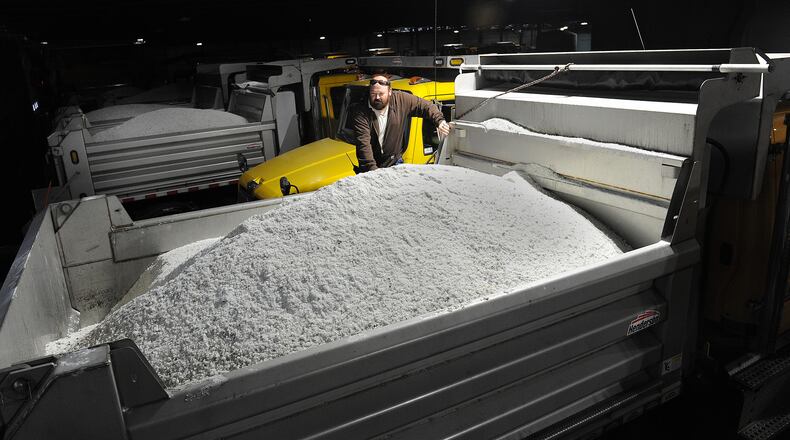“There’s still some uncertainty about how much sleet versus snow will fall, and that will make a difference in how much accumulation you get,” said NWS meteorologist Steve Hrebenach. “It’s very location-dependent.”
Regardless, every part of the Dayton region will see some type of storm impact through Friday morning, so city and county officials spent Wednesday preparing.
City of Dayton Public Works officials said they will prioritize snow and ice removal and street treatment. Officials are also calling for people to stay off the roads if possible and to drive carefully if not.
“If you don’t have to be out, do not go out,” said Tyler McCoy, the city’s emergency planner and preparedness officer. “That will minimize your risk of getting into an accident or getting injured if you were to fall.”
Credit: DaytonDailyNews
Montgomery, Greene, Miami, Preble, Warren, Butler, Clark and Champaign counties will be in a winter storm warning until 7 a.m. Friday, according to the National Weather Service. The forecast calls for snow and sleet, possibly mixed with freezing rain.
Dayton expects to have 44 snow plow and salt trucks on the roads around the clock, starting at about 3 a.m. Thursday when rain may turn to a wintry mix, and possibly lasting through Saturday, depending on snow accumulation and the condition of the roadways, said Fred Stovall, Dayton’s director of public works.
The forecast suggests sleet and ice will transition to snow on Thursday afternoon in Dayton, and the city will try to plow and salt as many of its 1,700 lane miles of roadways as it can, Stovall said.
“Our first focus will be the highways, the thoroughfares — what we call the arterials, to get you in and out of your neighborhood,” he said. “Just be patient, because it is a slow process for the residential (streets).”
Public works drivers will be on the roads for 16-hour shifts, and alternates will take over when their shifts end, Stovall said. Some water department employees will be reassigned to drive trucks assuming they aren’t responding to water main breaks.
The impact of the storm depends significantly on how much ice and sleet builds up, as that can lead to power outages.
“South of Dayton you’ll have more freezing rain hazards (instead of sleet),” said Hrebenach of NWS. “If you have enough accumulation of freezing rain on tree limbs, those can start falling on power lines and knocking them down. Sleet will mostly bounce off of things.”
Dayton may activate its “tier 2″ cold weather emergency plan, which includes using the city’s three recreation centers as warming centers during normal operating hours, McCoy said.
He continued, “We are ready to respond if we were to have power outage, but we’re praying that doesn’t happen and it’s just a snow event that we can deal with using snow plows.”
Citizens can help during this weather emergency by not parking along the roadways, to make it easier to plow and clear snow and ice, McCoy said.
The Montgomery County Office of Emergency Management will stand up an emergency operations center if necessary to provide support to local jurisdictions, director Jeffrey Jordan said.
The office’s role is to communicate and organize the response in getting aid like food and water to places where it’s needed in case of an emergency, Jordan said. He said residents need to stay home and avoid the dangers of the storm.
Giving work crews room to work is essential, Montgomery County Engineer Paul Gruner said. His office will have crews covering 310 miles of Montgomery County roads Thursday morning.
He said his office will monitor conditions, including the temperature of pavements, because figuring out when to start treating roads can be tricky.
“That’s always the problem we have with freezing rain, it’s a wasted effort if we get out there too early,” Gruner said. “When the pavement temperature gets down towards freezing, we’ll start to get out. We’re hoping to stay a little bit ahead of when it starts freezing.”
Elsewhere in the Montgomery County, Washington Twp. will have work crews begin treating roads as soon as the rain turns into ice.
The Washington Twp. RecPlex will operate as a warming center on Friday between 6 a.m. and 8 p.m., Saturday between 8 a.m. and 5 p.m. and Sunday between 10 a.m. and 5 p.m.
The City of Kettering’s Recreation Center will serve as a warming facility Thursday and Friday from 6 a.m. to 8 p.m. In Moraine, the Payne Recreation Center will be available as a warming center from 7 a.m. to 7 p.m. from Thursday and Friday.
Tips for the storm
Follow the forecast: To know what weather is coming next, visit daytondailynews.com or follow the National Weather Service’s local office at www.weather.gov/iln/, or @NWSILN on Twitter
About those cars: Tip No. 1 is simple — Don’t drive at all during a snow/ice storm unless it’s urgent. And move all vehicles off the street if possible so snow plows can work effectively.
If you must drive: Clean all snow/ice off your car to ensure visibility. Then drive slower, leave more space than usual between you and other vehicles, accelerate slowly, and begin braking before you think you need to.
What do snow emergencies mean: Level 1 just means to use caution when you drive. At Level 2, “only those who feel it is necessary to drive should be on the roadways.” But Level 3 means all roadways are closed to non-emergency personnel. At Level 2 and 3, employees should contact their employer to see if they should report to work.
Power outages: Make sure you have flashlights, a radio and functioning batteries ready in case the power goes out. Make sure you have bottled water and nonperishable food that can be eaten without heating. If you have a fireplace, check the flue before starting a fire. If you’re using space heaters, make sure they are well-ventilated and away from flammable objects.
Who to call: To report power outages, call AES at 877.468.8243. To report a down tree in the right-of-way, or problems with water mains, call your local city or township office. Only call 911 for medical or safety emergencies, not for information related to snow removal.


